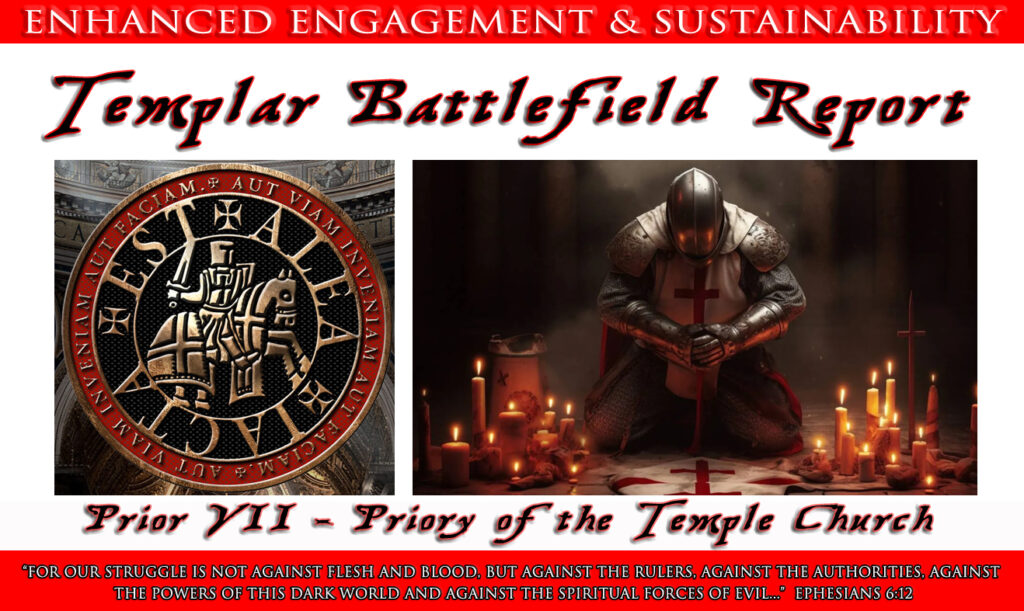

To all our Templar family in the path of Hurricane Helene today, we pray for your safety and peace. May our God be with you as we lift each of you in constant, fervent prayer!
————————————————————————————-
We 21st-century Templars often think of ourselves as “descendants of the original Templar Knights,” and so we are – at least in some respects. But, eventually, when looking back almost a millennium, the thought should occur to at least some of us, “Just how much has changed in the Order?”
The answer to that question is… A LOT!
When the Templars became a true international force to contend with, all of the political, religious, and economic complexities of such an organization came to rest at the feet of Pope Honorius II. The Pope enlisted the help of one of the Church’s most recognized and intellectually pious Clergy, Abbot Bernard of Clairvaux, assigning him in the year 1128 to assist at the Council of Troyes which formally set the stage for the Templar’s Papal recognition.

St. Bernard of Clairvaux
The Templars were subsequently officially established by the Holy See in 1129, catapulted to fame by the eloquence of Bernard of Clairvaux as much as the power and influence of the Pope himself, leaving authentically virtuous Clairvaux holding the reigns of the new legion of Christian Knights Templar.
The Templar Rule – The Templar Life
The truly pious Bernard of Clairvaux was very familiar with the hedonistic propensity of mainstream European knights. Therefore, he sought to immediately establish a guiding charter to head off the influence of the world before it became established as the norm in the Templars. Bernard traced the outlines of what soon became the Latin Rule, also known as the Specific Behavior for the Templar Order, and it set the foundation for the ideal of Christian nobility throughout Europe.
A rigid code of conduct was not out of line with the Knights Templar’s founding principles as a cloistered Christian Order. As a Cistercian monk himself, Bernard was well aware of the lifestyle of such a brotherhood in rigid conformity with the rules of the Cistercian monastic Order. He drew upon his experience to draft in 1128 the individual codicils that became the Templar’s Latin Rule, which was recorded in the Minutes of the Council of Troyes in 1129.
Comprising 72 formal rules, the Rule urged its followers to forsake worldly knighthood, focusing instead on promoting justice, protecting the vulnerable, and steering clear of unwarranted violence. Central to this code were the commitments to chastity and celibacy; members of this brotherhood were required to completely avoid interactions with women at any cost and remain unmarried.
The quarters of the monks were always brightly lit and knights were ordered to sleep fully clothed to prevent any sexual sins from occurring. Bernard of Clairvaux appeared to have been quite preoccupied with ensuring the knights lived properly as monks and did not slip back into the secular ways of non-monastic knights.
Bound by a monastic vow of poverty, the Knights Templar individually owned few possessions despite the Order’s overall wealth. Initially, these knights were impoverished, but as the Order prospered, individual knights could possess modest personal property. Typically, a knight needed about three thousand acres (around 4.6 square miles) to support his armor and household expenses. Therefore Templars were permitted to own land, a horse, and employ a few servants.
While their personal belongings were kept to a minimum, their status as both a knight and a monk meant they had slightly elevated living standards compared to typical monks. However, they were strictly limited in acquiring land beyond what was necessary to avoid amassing personal wealth.
The Rule also outlined dietary and fasting practices for the Templar knights. Meat was permitted only three times a week, under the belief that excessive consumption could corrupt the body. Meals were taken once or twice on Sundays, and twice or three times on Mondays, Wednesdays, and Saturdays. These meals were limited to vegetables and bread. On Fridays, the knights fasted, and they were instructed to minimize their food intake from November 1st (All Saints’ Day) until Easter.
And these examples are just a few of the rigid rules the Templars lived by. Here is a description of a standard monastic day:
A typical day in a religious Order was structured around regular prayer services known as the canonical hours. Monks were required to wake at 4 AM for the Matins service, tend to their horses, and then return to sleep until 6 AM for the Prime service. Following this, they attended Tierce at 9 AM and Sext at noon, with the morning also dedicated to caring for and training their horses.
After Sext, the monks enjoyed a meal of cooked meats in silence, accompanied by a chaplain reading from the Bible. This silence during meals was a common practice in monastic life, emphasizing obedience and contemplation.
The afternoon schedule included Nones at 3 PM, Vespers with dinner around 6 PM, and Compline at 9 PM. Post-Compline, monks could have wine and water before spending additional time with their horses. The day concluded with bedtime at midnight, after which silence was maintained until the next Matins service at 4 AM.1
So, how does your daily schedule compare to that of our forefather Templar Knight? Do you get the feeling for just how different one day in your modern life is from his? In a word, the difference is radical!
And yet, Jesus, the Captain of the Lord’s army, has called us to this time and this spiritual battlefield for His specific purpose. Our mission as 21st-century Templars – just like the mission of our warrior monk forefathers – is to always advance the Kingdom of God. And we live by the rule of God’s Word and His indwelling Holy Spirit of Grace!
-
https://www.rosslynchapel.com/wp-content/uploads/2020/02/256_Rosslyn_Article
